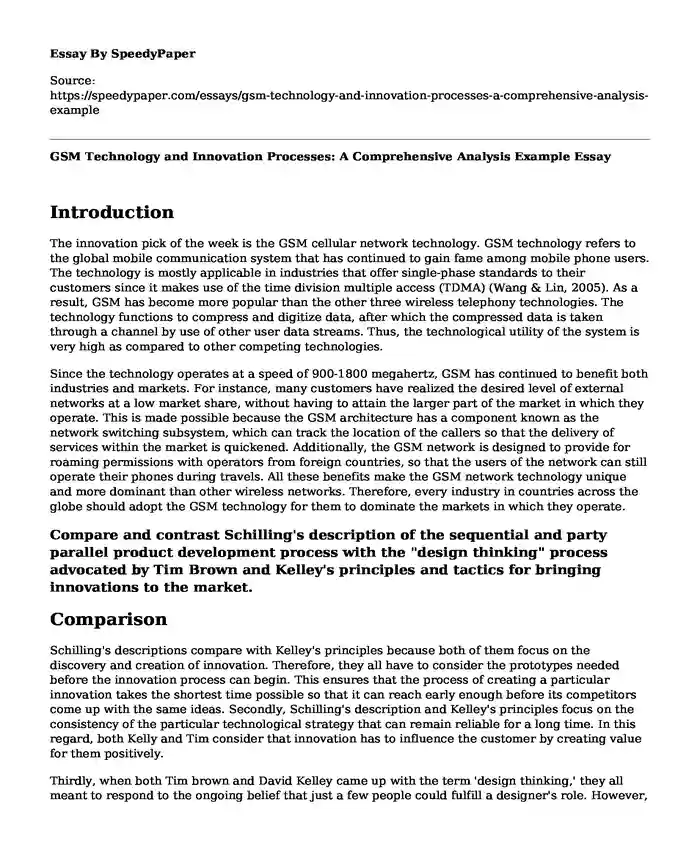
| Type of paper: | Essay |
| Categories: | Marketing Technology |
| Pages: | 3 |
| Wordcount: | 611 words |
Introduction
The innovation pick of the week is the GSM cellular network technology. GSM technology refers to the global mobile communication system that has continued to gain fame among mobile phone users. The technology is mostly applicable in industries that offer single-phase standards to their customers since it makes use of the time division multiple access (TDMA) (Wang & Lin, 2005). As a result, GSM has become more popular than the other three wireless telephony technologies. The technology functions to compress and digitize data, after which the compressed data is taken through a channel by use of other user data streams. Thus, the technological utility of the system is very high as compared to other competing technologies.
Since the technology operates at a speed of 900-1800 megahertz, GSM has continued to benefit both industries and markets. For instance, many customers have realized the desired level of external networks at a low market share, without having to attain the larger part of the market in which they operate. This is made possible because the GSM architecture has a component known as the network switching subsystem, which can track the location of the callers so that the delivery of services within the market is quickened. Additionally, the GSM network is designed to provide for roaming permissions with operators from foreign countries, so that the users of the network can still operate their phones during travels. All these benefits make the GSM network technology unique and more dominant than other wireless networks. Therefore, every industry in countries across the globe should adopt the GSM technology for them to dominate the markets in which they operate.
Compare and contrast Schilling's description of the sequential and party parallel product development process with the "design thinking" process advocated by Tim Brown and Kelley's principles and tactics for bringing innovations to the market.
Comparison
Schilling's descriptions compare with Kelley's principles because both of them focus on the discovery and creation of innovation. Therefore, they all have to consider the prototypes needed before the innovation process can begin. This ensures that the process of creating a particular innovation takes the shortest time possible so that it can reach early enough before its competitors come up with the same ideas. Secondly, Schilling's description and Kelley's principles focus on the consistency of the particular technological strategy that can remain reliable for a long time. In this regard, both Kelly and Tim consider that innovation has to influence the customer by creating value for them positively.
Thirdly, when both Tim brown and David Kelley came up with the term 'design thinking,' they all meant to respond to the ongoing belief that just a few people could fulfill a designer's role. However, through their teaching and learning experiences, the innovators realized that anyone could perform the designing task when provided with the right approach.
Differences
Despite the similarities between the innovator's ideologies, they differed in the approaches of their design thinking processes. For instance, Kelley's principle focuses more on the hardest part of design thinking to arrive at the right innovation (Kelley & Kelley, 2013). Schilling's descriptions focus on the simpler ways of approach required to follow a given strategy to complete a design process. Secondly, Kelley's principle provides for the construction of designs while considering its customers, suppliers, as well as competitors. On the other hand, the parallel product development process does not include the three entities when constructing their designs (Brown, 2008).
References
Brown, T. (2008). Design thinking. Harvard Business Review, 86(6), 84.
Kelley, T., & Kelley, D. (2013). Creative confidence: Unleashing the creative potential within us all. Currency.
Wang, F., & Lin, J. H. (2005). Design of SMS platform based on GSM network [J]. China Measurement Technology, 3.
Cite this page
GSM Technology and Innovation Processes: A Comprehensive Analysis Example. (2024, Jan 09). Retrieved from https://speedypaper.com/essays/gsm-technology-and-innovation-processes-a-comprehensive-analysis-example
Request Removal
If you are the original author of this essay and no longer wish to have it published on the SpeedyPaper website, please click below to request its removal:
- Essay Samples About Benefits of the Internet
- Software Use Success Criteria. Essay Sample.
- Essay Example on Network Management
- Essay Sample on Growing the Business with Search, Semantic, and Recommendation Technologies
- Overview of Walmart Company - Free Essay Example
- Paper Example: Is Technology Limiting Creativity?
- Information Management Today - Essay Sample
Popular categories




